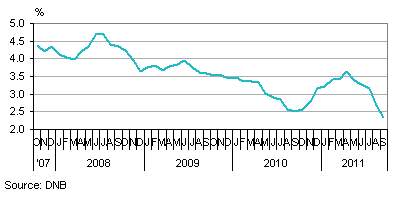Interest rate historically low

The Dutch long-term interest rate, based on the return of the most recent ten-year public loan, averaged 2.3 percent in September 2011, i.e. 0.4 of a percentage point down on August. The interest rate dropped for the fifth consecutive month and reached the lowest level in decades.
The European Central Bank (ECB) decided to raise various interest rates in July 2011. On 13 July, the repo rate and the deposit rate were both raised by 0.25 of a percentage point to 1.5 percent and 0.75 percent respectively. The deposit rate is often considered as the bottom rate of the money market. Both rates were also raised by 0.25 of a percentage point in April. In the preceding two years, the rates had remained unaltered.
One of the main guidelines for the ECB’s decision to change or refrain from changing the interest rate is the level of inflation in the eurozone. According to the ECB, prices in the eurozone are stable if the inflation rate is close to 2 percent. Eurostat, the statistical office of the European Union, recorded an inflation rate of 3.0 percent in the eurozone in September 2011, half of a percentage point higher than in August.
Capital market interest rate (latest ten-year government bond)
